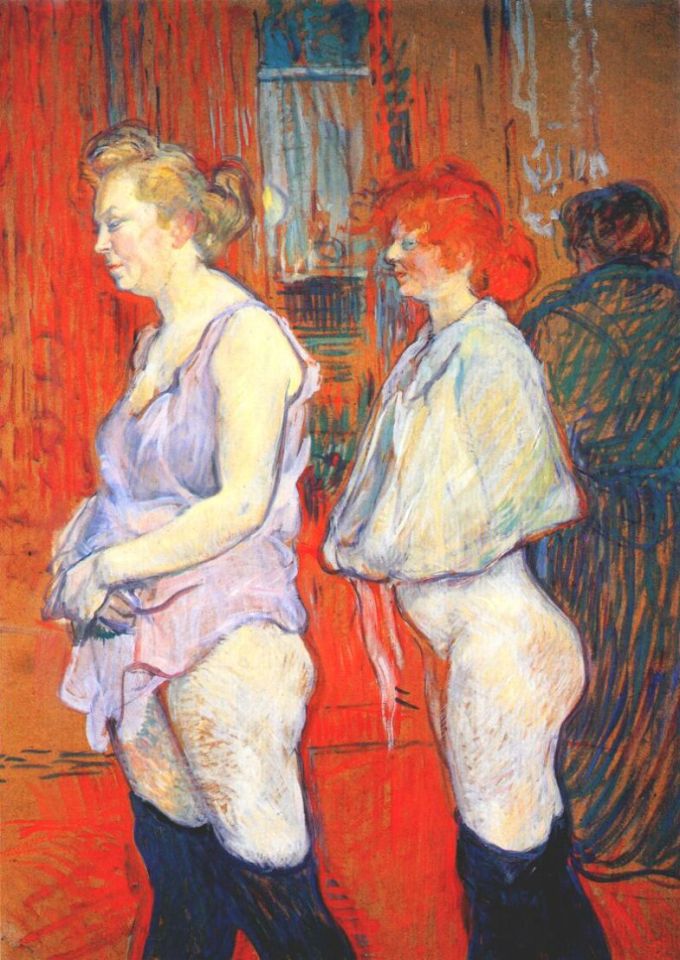
Engraving showing a man in a fumigation stove (1659), Jacques Laniet. A common treatment for syphilis at the time. Mercury would be placed inside the stove, and a fire would be started to vaporise the mercury around the patient.
Reader Question: “I remember hearing (learning?) years ago that some paintings depict people with physical indications of STDs. Perhaps syphilis? Is this true? Are other STDs depicted in art throughout history?”
Yes, this is true! This is a subject that really reflects how useful art history can be in studying the history of science and medicine, and how art has been used to educate people about medical conditions for hundreds of years. Beyond that, however, we can also use art to see how societal views of STDs have evolved – from simply fearful to judgmental and sexualised.
You’re right, by the way: syphilis is the STD that’s most commonly represented throughout art history, so it’s the one we’re going to focus on (with one brief depiction of gonorrhoea). Syphilis is one of the only STDs that have been around for a really long time (along with, again, gonorrhoea), so it is a disease that has been widely depicted in art history.
Let’s start with talking about how we can recognize syphilis in art. It’s hard to really pin down what syphilis looks like. It has so many possible symptoms that it’s known as “the great imitator” or “the great pretender”. You can be infected with syphilis and have very mild symptoms or none at all. However, syphilis usually leads to sores in the genital area and/or mouth, and itchy rashes that spread all over the body and often on the feet and hands. In its later stages, the disease can affect the brain, heart, vision or nervous system. Congenital syphilis – where the mother has passed on the disease to her child during birth – can lead to deafness, tooth deformities and saddle nose (where the bridge of the nose collapses).
In the 15th century, syphilis seems to have had slightly different symptoms than today. Scientist and historian Jared Diamond writes that, when syphilis was first definitively recorded in Europe in 1495, “its pustules often covered the body from the head to the knees, caused flesh to fall from people’s faces, and led to death within a few months”. He argues that, by 1546, the disease looked more like it does today. That means that when we look at artistic records of syphilis, it is important to keep in mind the variety of symptoms that syphilis can have, and how these symptoms have shifted over time.
The earliest possible artistic record that we have of syphilis comes from 4th century Peru, in the form of a clay jug, as suggested by R. S. Morton from the National Center for Biotechnology Information. This jug comes from a series of jugs that each show the symptoms of a particular disease, such as leprosy or leishmaniasis. The series is currently exhibited in the Musée de l’Homme in Paris.

Jug depicting a syphilitic mother with child (4th century), Peru. Photo from the National Center for Biotechnology Information.
The jug in question depicts a mother and child. The child appears potentially healthy, but the mother has two symptoms of congenital syphilis: a collapsed nasal bridge, and dental deformities. The fact that she is depicted with a baby could indicate that the jug potentially served as a warning about the dangers of passing on syphilis to your children.
Let’s skip ahead to 15th century Europe; specifically, the last part of the century, starting more or less around 1490. This is when the first syphilis epidemic broke out in Europe, which gives us an influx of illustrations intended to warn and educate people about syphilis. At the time, the disease was not yet clearly associated with sexual activity. It was, however, quite widespread and well known. During this time, symptoms could be quite severe and often fatal. One description of the disease states that “his nose dropped off”, while another states that “the face had been eaten away by pox, with exception of a bit of beard on the chin”.
The rise of printing techniques in this time allowed for artistic prints and pamphlets to be widely distributed. German artist Albrecht Dürer (although it could also be the work of his master, Wolgemut) created a woodcut illustration that was printed together with a broadsheet written by Nuremburg physician Theodorus Ulsenius, warning against the dangers of syphilis. It was created and distributed in 1496. The text describes the signs and symptoms of the disease and states that it cannot be cured. It also claims that there is a connection between the epidemic and the “grand conjunction” of 1484. This was a planetary constellation that belonged to a cycle of constellations supposedly leading up to the “last days of the world” – in other words, syphilis was basically a sign of the apocalypse.

Albrecht Durer, Broadsheet: text and wood cut of a syphilitic. Credit: Wellcome Collection. Attribution 4.0 International (CC BY 4.0)
The illustration depicts a syphilitic man, and the grand conjunction is represented through the astrological signs with the numbers “1484” above the figure’s head. The man’s skin is covered in sores and rashes, two common symptoms of syphilis. The two coats of arms floating next to him represent the city of Nuremberg. There were quite a few of this type of informative pamphlet about syphilis, and their spread made syphilis a prevalent issue.

Sebastian Brandt, Syphilis: Woodcut: 1496. Credit: Wellcome Collection. Attribution 4.0 International (CC BY 4.0)
When it became clearer that syphilis was connected to sexual activity, many artistic representations of the disease became imbued with a distinct sense of moral judgment. This can be seen as early as the 1490s. A 1496 woodcut print by Sebastian Brandt depicts the Virgin Mary and the Christ child punishing the infected by shooting them with arrows. Here, those infected with syphilis – marked as such through the sores on their skin – are treated like sinners, signalling an early awareness that the disease could be connected with sex.

Saint Denis praying to the Virgin and Child for help to overcome the curse of Syphilis (1496 – 97), Georg Stuchs. Image from the National Centre for Biotechnology Information.
Syphilis was so widespread at the time that it even had a patron saint: the headless Saint Denis. A 1496 – 97 woodcut of Saint Denis by Georg Stuchs shows him next to the Virgin Mary, accompanied by a prayer. This sort of print would have hung by a patient’s bedside, with the prayer asking Saint Denis to intervene and alleviate the suffering of the infected.

Head of a young man (1523), Hans Holbein the Younger.
The reason that this time period in Europe is so useful for our purposes is that we know for sure that the artworks are about syphilis, because of the accompanying texts and the context of the syphilis epidemic. However, there are examples of artworks later on that are harder to diagnose. An example of this is Hans Holbein the Younger’s Head of a young man from 1523, which shows a man whose face is covered in lesions. While some historians have diagnosed him as suffering from syphilis, others disagree and argue that it must be leprosy, or a different disease entirely. Like I mentioned earlier, syphilis is “the great imitator” and can be very difficult to diagnose from just an image.

Portrait of Gerard de Lairesse (1656), Rembrandt van Rijn
By the beginning of the 17th century, the European epidemic of syphilis was over and there was a decline in the number of artistic representations of the disease. Depictions of syphilis from now on were usually confined to medical handbooks and educational materials. One notable exception is famous Dutch painter Rembrandt van Rijn’s portrait of Gerard de Lairesse, who suffered from congenital syphilis, in 1656. The sympathetic and dignified portrait shows de Lairesse with a flattened nasal bridge. He would eventually go blind from the disease in 1690.

“Pills to cure toxic illnesses such as syphilis and gonorrhoea” (19th century), unknown artist.
As we have seen, medical illustrations and educational materials are consistent sources of syphilis depictions. Other useful sources are posters and advertisements, as we see in this example from 19th century Japan. I chose this particular poster because it actually shows the physical symptoms of syphilis, and, in this case, of gonorrhoea. It’s an advertisement for “pills to cure toxic illnesses such as syphilis and gonorrhoea” and follows a before and after model where the subjects at the top show clear symptoms of the diseases. Especially notable are the sores and lesions on the woman’s face, and the deformity of the man’s nose and teeth, in line with both regular and congenital syphilis.

The medical inspection (1894), Henri de Toulouse-Lautrec
To finish off, I want to touch on the connection between syphilis and the stigmatisation of female sexuality. In 18th and especially 19th century Europe, representations of syphilis were often connected to “dangerous” female sexuality, and especially to sex workers. Impressionist painter Edgar Degas, for example, once stated that French artist Henri Toulouse-Lautrec’s paintings of sex workers “stank of syphilis”.

Syphilis (1900), Richard Tennant Cooper
Similarly, in Richard Tennant Cooper’s painting Syphilis, we can see that the disease (which is represented as an evil-looking supernatural creature) has been brought to the man by the naked woman in the room. In this way we can see that judgmental and harmful attitudes regarding women’s sexuality have been connected to syphilis and its depictions for a very long time.
Finally, we come to the very end of the 19th century, with Norwegian painter Edvard Munch and his artwork The Inheritance from 1897 – 99. The painting shows a mother with a child that has congenital syphilis in her lap. It was based on an experience that Munch had in a hospital waiting room, observing the scene play out in front of his eyes. The child’s body shows symptoms of congenital syphilis; namely a red rash on its chest, and a deformed body. The painting provoked strong reactions when it was first exhibited.

The inheritance (1897 – 1899), Edvard Munch. One of several versions.
So, to answer your question: yes, there are many artworks depicting the physical indicators of STDs – specifically syphilis – going quite far back in history. I’ve really only scratched the surface here. Depictions of syphilis have ranged from straight-forward representations of symptoms in medical journals, to educational illustrations, to posters, and to portraits and figurative compositions.
By tracing the evolution of this imagery we can see how attitudes towards syphilis have shifted and evolved, but also stayed the same. Every representation of syphilis seems to be imbued with a mixture of fear, curiosity and judgment. The sufferers’ physical symptoms are often dwelled upon with a mixture of disgust and fascination. Consistently, we see that the artists seek to implicitly place the blame on something and someone – the sufferers themselves, the dangerous women who infect men, or simply apocalyptic fate. Wrapped up in these depictions, then, is also the hope of salvation from death: take these pills. Pray to this saint. Don’t have sex. Save yourself. It is this mixture of hope, revulsion, fear and judgment that make these seemingly different depictions so strangely similar and, ultimately, so captivating.

Kendall
Awesome Impression! I cannot believe you have not received many acclimations for this article. Thank you
Ishita
I cannot believe that this blog existed and I didn’t see it until now!
Thank you for all your informative posts. You have answered my question without patronizing me as the reader and for that, I applaud you.
Please keep up the good work.
Lina
Wonderful post, thank you!